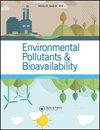Effects of bleaching wastewater irrigation on soil quality of constructed reed wetlands
Q3 Chemical Engineering
引用次数: 2
Abstract
Abstract Constructed reed wetland microcosms (CRWs) in a lab of east China have been irrigated with bleaching wastewater per month for a reed growth season. The soil physicochemical properties, enzyme activities (i.e. urease, invertase, polyphenol oxidase, alkaline phosphatase and cellulase) and soil microbial diversity were assayed before and after the exposure experiment. Compared to the river water irrigated controls (CKs), bleaching wastewater application has no marked influence on soil pH, but significantly increased soil Na+, total halogen and absorbable organic halogen (AOX) contents, which induced the increasing of soil electrical conductivity. Furthermore, soil enzyme activities displayed significant variation (except for polyphenol oxidase). Bleaching wastewater irrigation decreased Sorenson’s pairwise similarity coefficient (Cs), which indicated the changes of the structure of bacterial and fungal communities. However, only the diversity of bacterial community was inhibited and has no effect on the diversity of fungal community, as evidenced by the calculated Shannon–Wiener index (H).漂白废水灌溉对人工芦苇湿地土壤质量的影响
摘要/ Abstract摘要:在芦苇生长季,采用漂白废水每月灌溉人工芦苇湿地(CRWs)。测定暴露前后土壤理化性质、酶活性(脲酶、转化酶、多酚氧化酶、碱性磷酸酶和纤维素酶)及土壤微生物多样性。与河水灌溉对照(ck)相比,施用漂白废水对土壤pH值无显著影响,但显著提高了土壤Na+、总卤素和可吸收有机卤素(AOX)含量,导致土壤电导率升高。此外,除多酚氧化酶外,土壤酶活性也存在显著差异。漂白废水灌溉降低了Sorenson’s配对相似系数(Cs),表明细菌和真菌群落结构发生了变化。但仅抑制了细菌群落的多样性,对真菌群落的多样性没有影响,计算的Shannon-Wiener指数(H)证明了这一点。
本文章由计算机程序翻译,如有差异,请以英文原文为准。
求助全文
约1分钟内获得全文
求助全文
来源期刊
CiteScore
1.62
自引率
0.00%
发文量
0
审稿时长
1 months
期刊介绍:
Chemical Speciation & Bioavailability ( CS&B) is a scholarly, peer-reviewed forum for insights on the chemical aspects of occurrence, distribution, transport, transformation, transfer, fate, and effects of substances in the environment and biota, and their impacts on the uptake of the substances by living organisms. Substances of interests include both beneficial and toxic ones, especially nutrients, heavy metals, persistent organic pollutants, and emerging contaminants, such as engineered nanomaterials, as well as pharmaceuticals and personal-care products as pollutants. It is the aim of this Journal to develop an international community of experienced colleagues to promote the research, discussion, review, and spread of information on chemical speciation and bioavailability, which is a topic of interest to researchers in many disciplines, including environmental, chemical, biological, food, medical, toxicology, and health sciences.
Key themes in the scope of the Journal include, but are not limited to, the following “6Ms”:
Methods for speciation analysis and the evaluation of bioavailability, especially the development, validation, and application of novel methods and techniques.
Media that sustain the processes of release, distribution, transformation, and transfer of chemical speciation; of particular interest are emerging contaminants, such as engineered nanomaterials, pharmaceuticals, and personal-care products.
Mobility of substance species in environment and biota, either spatially or temporally.
Matters that influence the chemical speciation and bioavailability, mainly environmentally relevant conditions.
Mechanisms that govern the transport, transformation, transfer, and fate of chemical speciation in the environment, and the biouptake of substances.
Models for the simulation of chemical speciation and bioavailability, and for the prediction of toxicity.
Chemical Speciation & Bioavailability is a fully open access journal. This means all submitted articles will, if accepted, be available for anyone to read, anywhere, at any time. immediately on publication. There are no charges for submission to this journal.

 求助内容:
求助内容: 应助结果提醒方式:
应助结果提醒方式:


